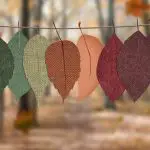Starting DIY fabric projects can be incredibly satisfying, even if you're new to sewing and crafting. You'll need some key tools like sharp scissors, quality cutting tools, and precise measuring instruments to get going. Picking the right fabric is just as important—it's not just about the look but also the weight, durability, and texture. Mastering basic stitching techniques such as the running stitch and backstitch will open up a world of possibilities. So, where do you begin, and what can you create with these newfound skills? The answer lies just ahead.
Table of Contents
Key Takeaways
- Choose high-quality cutting tools like rotary cutters and fabric scissors for precise and clean cuts.
- Start with simple projects such as tote bags, pillow covers, and fabric coasters to practice basic stitching techniques.
- Use running stitch, backstitch, and slip stitch for versatile, durable, and invisible seams.
- Pre-wash and properly store fabrics to prevent shrinkage and maintain their quality.
- Select appropriate fabrics considering weight, color, durability, texture, and pattern alignment to enhance your design vision.
Essential Tools and Materials
To kick off your DIY fabric projects, you'll need a few essential tools and materials to get started. First and foremost, invest in high-quality cutting tools. A pair of sharp fabric scissors is non-negotiable; they ensure clean cuts without fraying the fabric. Additionally, a rotary cutter can be a game-changer for cutting straight lines and intricate patterns with precision. Don't forget a self-healing cutting mat to protect your surfaces and ensure smooth cuts.
Measuring instruments are equally crucial for achieving professional results. A sturdy tape measure lets you measure fabric lengths and widths accurately. For smaller, more detailed measurements, a clear acrylic ruler is indispensable. It provides precise, straight lines and can double as a guide for your rotary cutter. A seam gauge is another handy tool, perfect for marking hems and seam allowances.
To elevate your projects further, consider a fabric marking pen or tailor's chalk for tracing patterns and marking adjustments. These tools help you visualize your project and make precise alterations.
With these cutting tools and measuring instruments, you're well-equipped to tackle any DIY fabric project with confidence and skill.
Choosing the Right Fabric
Selecting the right fabric is just as essential as having the proper tools and materials. Your fabric choice can make or break your DIY project, so it's vital to understand the nuances.
First, consider fabric weights. Light fabrics like chiffon are great for flowy garments, while heavier ones like denim are perfect for structured items.
When choosing fabric, keep these factors in mind:
- Fabric weights: Match the weight of the fabric to your project type. Heavier fabrics provide structure; lighter ones offer drape.
- Color selection: Choose colors that complement your style and the project's purpose. Vibrant hues can energize, while neutrals can offer versatility.
- Durability: For items that will see heavy use, opt for sturdy fabrics like canvas or twill.
- Texture: The fabric's feel against the skin matters, especially for clothing. Soft fabrics like cotton are comfortable, while rougher textures like burlap are better suited for décor.
- Print and Pattern: Ensure the pattern aligns with your design vision. Large prints can be bold, while small patterns offer subtlety.
Carefully considering these elements will elevate your DIY fabric projects, making them not just handmade but skillfully crafted.
Basic Stitching Techniques
Mastering a few basic stitching techniques will empower you to tackle a wide range of DIY fabric projects with confidence. Whether you're diving into embroidery basics or honing hand sewing techniques, the foundation you build will be invaluable. Let's explore three essential stitches that will elevate your skills.
| Stitch Type | Description |
|---|---|
| Running Stitch | Simple and versatile, perfect for seams or gathering fabric. |
| Backstitch | Strong and durable, ideal for repairing seams and creating outlines in embroidery. |
| Slip Stitch | Invisible finish, great for hemming and closing seams in patchwork projects or quilt making. |
Understanding these stitches will set you up for success in various projects. The running stitch is your go-to for basic seams and can be a lifesaver in hand sewing techniques. For a more durable option, the backstitch offers strength and precision, vital for embroidery basics and intricate designs. Finally, the slip stitch provides a seamless finish, essential in quilt making essentials and patchwork projects.
Simple Sewing Projects
Now that you've got the basic stitching techniques down, let's put them to use with some simple sewing projects you can start today. These projects are perfect for honing your skills and experimenting with upcycling ideas. By choosing beginner patterns, you can create fantastic and functional items with ease.
Here are some simple sewing projects to try:
- Tote Bag: A versatile tote bag is a great project for beginners. You'll practice straight stitching and create something useful for everyday errands.
- Pillow Covers: Spruce up your living space by making custom pillow covers. This project is ideal for practicing your sewing skills and experimenting with different fabrics.
- Fabric Coasters: Protect your surfaces with stylish fabric coasters. These are small, quick fixes that allow you to use leftover fabric scraps.
- Drawstring Bag: Perfect for storing small items, a drawstring bag is a practical project that helps you get comfortable with making pockets and drawstrings.
- No Sew Projects: For a quick and easy project, try making a fabric headband or a scarf using fabric glue or iron-on adhesive. No sewing required!
Fabric Care Tips
Proper fabric care guarantees your handmade projects last longer and maintain their beauty. Start with effective stain removal techniques. Treat stains promptly by blotting (not rubbing) with a clean cloth. Use a mild detergent and cold water for most fabrics, but always check fabric-specific instructions. White vinegar or baking soda can be excellent natural alternatives for tougher stains.
When it comes to laundry tips, always pre-wash fabric before starting a project to prevent shrinkage and color bleeding. Wash similar colors together and use a gentle cycle to avoid damaging delicate fabrics. Air drying is preferable, but if you must use a dryer, opt for a low heat setting.
Organizing your fabric is equally important. Fabric storage should be in a cool, dry place, away from direct sunlight to prevent fading. Use acid-free boxes or fabric bins to protect against dust and pests. For added organization, sort fabrics by type and color.
Rolling your fabric instead of folding can help prevent creases and save space. Labeling each section or bin with the fabric type and yardage ensures quick access when inspiration strikes.
Frequently Asked Questions
How Do I Troubleshoot Common Sewing Machine Problems?
First, maintain sewing machine by cleaning and oiling it regularly. For troubleshooting tips, check the needle's position, thread tension, and bobbin placement. Master these basics, and you'll resolve most common issues efficiently.
What Are Some Eco-Friendly Fabric Options for DIY Projects?
You can opt for sustainable alternatives like organic cotton or bamboo. Natural fibers such as hemp and linen are great choices too. Upcycling materials from old clothes also helps in reducing waste, making your projects eco-friendly.
Can I Repurpose Old Clothes for New Fabric Projects?
Absolutely, you can repurpose old clothes for new fabric projects. By employing upcycling techniques and creative reimagining, you'll transform worn garments into unique, sustainable pieces, mastering the art of eco-friendly crafting.
How Do I Store Fabric to Prevent Damage?
To guarantee proper storage and prevent damage, you should fold fabric neatly, store it in a cool, dry place, and use acid-free tissue paper. Avoid direct sunlight and make sure your storage area is pest-free for ideal preservation.
Are There Online Communities for DIY Fabric Project Enthusiasts?
Yes, you'll find online forums and community groups buzzing with fabric project inspiration and tips. They're perfect for connecting with like-minded enthusiasts, sharing your progress, and learning new techniques to master your craft.
- DIY Tutorial: How to Make a Fabric Crochet Hook Case (Roll-Up Style) - June 25, 2025
- How to Sew a Padded Fabric Ukulele Case: A Musician’s DIY Guide - June 25, 2025
- The Pros and Cons of Using a Fabric Phone Case Every Day - June 25, 2025







